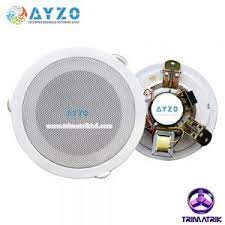Home / PA (Public Addressing ) System / PA System -AYZO/BOSCH

PA System -AYZO/BOSCH
R-EVAC-6Z-500W
- The router is needed for more than 6 zone voice alarm system
- Built-in 500W class-D amplifier
- Integration of EVAC controller, paging system, PA system & BGM system together
- Capacity of connection 32 remote microphones
- 6 zone speaker outputs with separate zone volume control (ATT)
A-EVAC-6Z-240W
- 6 Zone EVAC Controller
- Built-in 240W class-D amplifier
- Built-in EVAC and alert voice message by SD card
- Integration of EVAC controller, paging system, PA system & BGM system together
- Zone capacity of 120 zones by cascaded 19 routers
A-BT-4Z-60W
- Three microphone inputs & two auxiliary inputs
- Four zones with individual volume & tone control
- 4 ohms, 70V and 100V speaker output
- 60-1000W RMS
- Five element LED level to monitor sound level
- USB, Bluetooth, MMC, FM compatible
- Wireless remote control
- Mute function
- Short-circuit protection with alarm
Product Details
A Public Address (PA) system, also known as a sound reinforcement system, is a technology used to amplify and distribute audio, allowing sound to be heard by a larger audience in various settings. PA systems are commonly used in a wide range of applications, from small gatherings and meetings to large events and concerts. Here are some key aspects of PA systems:
Components of a PA System:
Microphones: These are the input devices that capture sound, converting it into an electrical signal. There are different types of microphones, such as dynamic, condenser, and wireless, suitable for various applications.
Mixer: A mixer is used to adjust the levels, equalization, and routing of audio signals. It allows you to balance the sound from multiple microphones and sources.
Amplifiers: Amplifiers boost the low-level audio signals from the mixer to a sufficient level to drive loudspeakers effectively.
Loudspeakers: These are the output devices that broadcast the amplified audio to the audience. There are different types of loudspeakers, including passive and powered (active) speakers.
Signal Processors: Signal processors like equalizers and compressors can be used to shape the sound and control dynamics in a PA system.
Cabling: Proper cables and connectors are essential for connecting all the components together.
Power Supply: PA systems often require a stable power source to operate reliably.
Types of PA Systems:
Portable PA Systems: These are compact, easily transportable systems suitable for small events, outdoor gatherings, and public speaking engagements.
Installed PA Systems: Installed systems are permanently fixed in a venue, such as in churches, theaters, or conference rooms.
Concert PA Systems: Large-scale systems used in music concerts and festivals, consisting of powerful amplifiers and multiple loudspeakers.
Emergency PA Systems: These systems are used for emergency notifications in public spaces, schools, and workplaces.
Touring PA Systems: Designed for the needs of touring musicians and production companies, these systems are highly versatile and scalable.
Applications of PA Systems:
Public Speaking: PA systems are commonly used by speakers, lecturers, and presenters to ensure their voice is heard by the audience.
Live Music: Concerts and live music performances rely on PA systems to deliver sound to large crowds.
Worship Services: Many religious institutions use PA systems to amplify sermons, music, and prayers.
Sports Events: PA systems are used in sports stadiums and arenas to provide commentary, music, and announcements during games and events.
Business and Education: PA systems are employed in corporate boardrooms, classrooms, and training facilities for effective communication.
Considerations for Choosing a PA System:
Venue Size: The size of the venue and the number of listeners will determine the power and coverage requirements of the PA system.
Audio Quality: Ensure the system can provide clear and high-quality sound, especially for music and professional applications.
Portability: Consider the ease of setup and transport for portable systems.
Budget: PA systems can vary greatly in cost, so it's important to match your budget with your needs.
Integration: For installed systems, consider how the PA system will integrate with existing audio equipment.
PA systems play a crucial role in facilitating effective communication and entertainment in various settings, making them a valuable technology in many industries and applications. When selecting a PA system, it's essential to carefully assess your specific requirements to choose the right components and configurations for your needs.